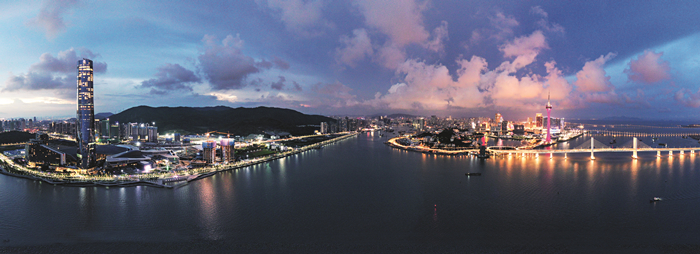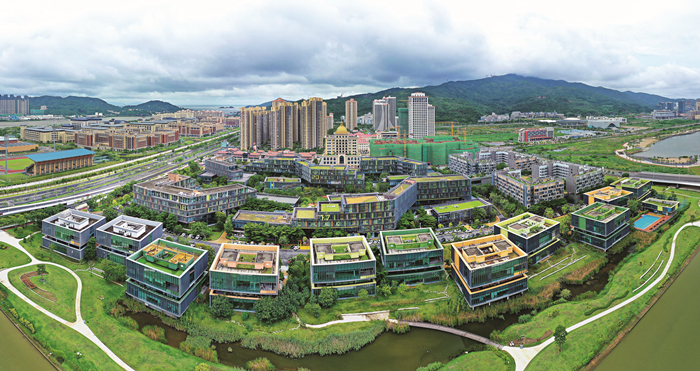|
||||||||||
| Home Nation World Business Opinion Lifestyle ChinAfrica Multimedia Columnists Documents Special Reports |
|
||||||||||
| Home Nation World Business Opinion Lifestyle ChinAfrica Multimedia Columnists Documents Special Reports |
| Current Cover Story |
| Forging Ahead |
| The Guangdong-Hong Kong-Macao Greater Bay Area has harvested rich fruits since its creation three years ago |
| Edited by Hu Fan 丨VOL. 14 MAY 2022 ·2022-04-26 |

A night view of Zhuhai (left) and Macao (right) on September 20, 2020 (XINHUA)
China issued the Outline Development Plan for the Guangdong-Hong Kong-Macao Greater Bay Area (GBA) in 2019, which launched the synchronized development of the area made up of 11 cities in the Pearl River Delta: Hong Kong, Macao and nine cities of Guangdong Province, including Guangzhou, Shenzhen and Zhuhai.
In the past three years, the construction of the area has achieved remarkable results, with a significant increase in overall strength, deeper and more extensive cooperation, new breakthroughs in intra-regional connectivity, and a stronger sense of access for the people in the area.
The area, one of the most open and economically dynamic areas in China, is making solid progress toward becoming a top bay area and city cluster in the world.
Growing strength
The construction of the area is a high-priority national strategy personally planned, deployed and promoted by Chinese President Xi Jinping to better include Hong Kong Special Administrative Area (SAR) and Macao SAR in the country’s overall development blueprint. The past three years have seen accelerated progress in implementing the initiative in the area that covers 56,000 square km with a population of about 70 million.
Data show that in 2021, the overall economic volume of the area was about 12.81 trillion yuan ($2.01 trillion). The area is home to 25 of Fortune Global 500 companies, more than 50 unicorn companies, more than 1,000 business incubators and nearly 15,000 investment institutions.
The area’s innovation ability and core competitiveness have also been enhanced. According to reports of the World Intellectual Property Organization, the Shenzhen-Hong Kong-Guangzhou science and technology cluster ranked second in the Global Innovation Index in the last three years, surpassing the San Jose-San Francisco cluster in the U.S., where Silicon Valley is located.
In September 2021, two initiatives were launched to build cooperation zones in Hengqin in the city of Zhuhai and Qianhai in the city of Shenzhen, respectively. As major pilot platforms for innovation in the area, both zones have shown strong momentum for growth.
In Hengqin, industrial integration of Guangdong Province and Macao SAR in diversified sectors is going on. Key industries such as high-end manufacturing, traditional Chinese medicine (TCM) and modern finance are developing rapidly, and the opening up is accelerating against the unfavorable trend of international trade. A number of Macao-invested projects have been signed. By the end of 2021, a total of 4,761 Macao-invested companies have been set up in the zone. The TCM industrial park, for example, now has over 220 pharmaceutical companies from Macao, as well as Hong Kong and the mainland.
In Qianhai, intensified cooperation is taking place between Shenzhen and Hong Kong. With strong policy support in financing, industrial development and human resources, cooperation between the two cities in sectors such as modern finance, technological innovation, and professional services has further deepened. By the end of 2021, the total number of Hong Kong-invested companies registered in Qianhai has reached 11,900, and Hong Kong capital accounts for 93.2 percent of all capital from outside the Chinese mainland in actual use in the zone. Qianhai has become one of the areas in the mainland with the closest connection with Hong Kong.
With the two cooperation zones as linking points, a network of technological innovation capacity has taken shape with the Guangzhou-Shenzhen-Hong Kong and Guangzhou-Zhuhai-Macao corridors as the backbones. A batch of key scientific facilities such as the Guangzhou Laboratory focusing on pandemic control studies, the accelerator-driven transmutation device in Huizhou and Peng Cheng Cloud Brain II, a cloud computing device for artificial intelligence research, have been built in the area and are serving the needs of more than 220 scientific research experiments in sectors such as superconducting materials and new materials for hydrogen storage.
Hi-tech industries are among top priorities of the cities in the area. In Nansha District of Guangzhou, for example, more than 500 life and health, and artificial intelligence companies have been established, while Shenzhen has targeted at building industrial chains in integrated circuits, biomedicine, new energy vehicles and five other sectors. The area is accelerating its pace to become a global highland of technological innovation and an important source of emerging industries.

A view of Shenzhen-Hong Kong Modern Service Industry Cooperation Zone in Qianhai, Shenzhen, Guangdong Province, on September 8, 2021 (XINHUA)
Higher connectivity
Promoting synchronized innovation and close cooperation in the area represents an unprecedented exploration since the area, though belonging to the same country, has two different political systems and comprises three different customs zones each using its own currency. Thus, the strongest possible national policy support has been given to the area to encourage bold attempts for breakthroughs. In the past three years, Guangdong Province, Hong Kong SAR and Macao SAR have been aligning with each other in terms of rules and mechanisms and connecting with each other through infrastructure to form a more integrated market.
One major project under way is the Zhongshan-Shenzhen Bridge, another super transportation infrastructure in the Pearl River Delta after the Hong Kong-Zhuhai-Macao Bridge that was put into operation in late 2018. Set to be completed and opened to traffic in 2024, the 24-km bridge will shorten travel time between Zhongshan and Shenzhen from 2 hours to 20 minutes.
The facilitation of transportation in the area is three-dimensional. For underground transportation, Guangzhou Metro Line 18, the metro line with the highest speed in the area, was put into operation. For air transportation, expansion of airports is in progress in Guangzhou and Shenzhen, and a new airport in Foshan has been approved.
Two new ports were set up to facilitate the flow of people and goods between Guangdong Province and Hong Kong SAR as well as Macao SAR. Existing ports are being renovated or reformed with higher efficiency in customs clearance. At the same time, the area is promoting the integration of inter-city public transportation to allow passengers to travel in the area with one ticket.
Apart from hard transportation infrastructure, “soft connectivity,” i.e., alignment of systems and rules, has also been promoted. Measures have been taken to overcome these differences and even turn them into advantages, and progress has been seen in various sectors.
In the field of financial innovation, the Cross-Border Wealth Management Connect Scheme has facilitated flow of capital in the area. Launched in September 2021, the scheme allows eligible mainland, Hong Kong and Macao residents in the area to invest in wealth management products offered by banks in each other’s market. A breakthrough of the mechanism is the considerable degree of flexibility given to individual retail investors to open and operate cross-border investment accounts directly and to choose their preferred products. As of the end of 2021, a total of 5,855 fund transfers worth 486 million yuan ($76.2 million) have been made via the scheme, with more than 60 banks across the area participating, attracting 22,000 investors.
In terms of the flow of human resources, by the end of last year, 402 physicians from Hong Kong and Macao have obtained qualification certificates to practice in the mainland, and 707 lawyers from the two cities have taken the area’s qualification examination for lawyers. Altogether, cross-border practice is facilitated for professionals in 16 sectors such as finance, taxation, and architecture.
A breakthrough was also made in applying unified standards for industries in the area. In January 2022, the Guangdong Administration for Market Regulation announced the development of the first batch of 70 GBA standards, covering 23 industries including food, TCM and transportation. The goal is that products in the area are tested and certified only once following unified standards before going to market.

A view of Hengqin Innovalley in Zhuhai, Guangdong Province, on July 30, 2021 (XINHUA)
Valuable opportunities
For Hong Kong and Macao, the implementation of national strategies like the Belt and Road Initiative and the GBA Development Plan represents major new opportunities, according to President Xi. He pointed out that although the two cities have their own advantages, they also face challenges for further development. Integrating into the overall development of the country has provided them with new paths, space and momentum for development.
The new opportunities are best felt by young people from Hong Kong and Macao who have started a career in cooperation zones like Qianhai and Hengqin. Huang Yin, who was born in Macao and now heads a startup in the medicine business, is one of them.
On a typical day, she and her team would promote the medical products they represent in the streets of Macao and return in the afternoon to their office in Hengqin in Zhuhai, which is 20 minutes away by car thanks to the Hengqin Bridge linking the two places.

A company representative talks to job seekers in a job fair held in a university in Zhuhai, Guangdong Province, on December 4, 2021 (XINHUA)
Initially she started a business in Macao but it didn’t work well. She was attracted to Hengqin in 2019 by a presentation made by Hengqin authorities in Macao about policies for young Macao people starting businesses in Hengqin, and started her current business in Hengqin Innovalley, an incubator for business projects.
Policy support there was generous. The startup enjoyed benefits such as concessionary office rent and free business trainings. She and several staff members from Macao were granted subsidies for renting apartments. “This has reduced the cost of running the company and allowed us to settle down here,” she said.
It didn’t take long before they got busy. Many companies from the mainland reached them to discuss cooperation possibilities to sell medicine in Macao. The company is now introducing fine Macao medical resources to the mainland, and those of the mainland to Macao, Southeast Asia and even some Portuguese-speaking countries.
With an initial success in Hengqin, Huang recommended it to her friends in Macao and more than 10 of them have come and started their businesses here.
By the end of February, 2,394 startups have been established in around 70 incubators in the area, attracting 3,455 young people like Huang from Hong Kong and Macao, according to the Human Resources and Social Security Department of Guangdong Province.
Overall, the province has registered the employment of 85,100 people from Hong Kong and Macao, and 195,400 people from these cities have become holders of Guangdong’s social security card.
While the establishment of the area provides opportunities for individuals from Macao and Hong Kong, as well as those from other places of the country, the pooling of people and resources there will propel the emergence of one of the world’s top bay areas that the GBA is intended to become.
|
||||||||||||
| About Us | Contact Us | Advertise with Us | Subscribe |
| Copyright Beijing Review All rights reserved 京ICP备08005356号-5 京公网安备110102005860号 |